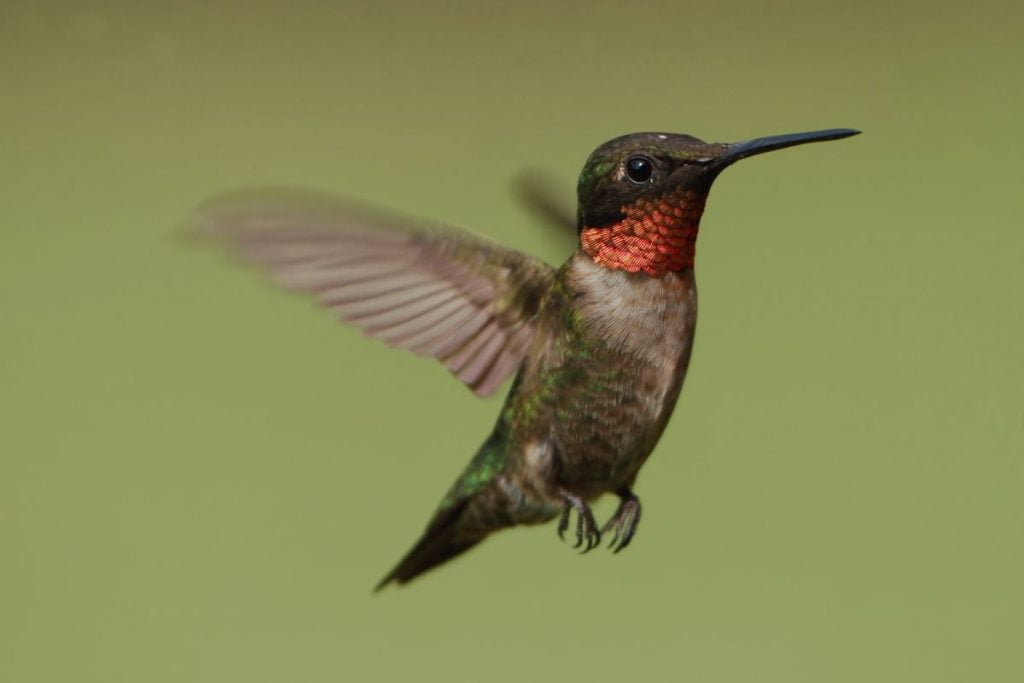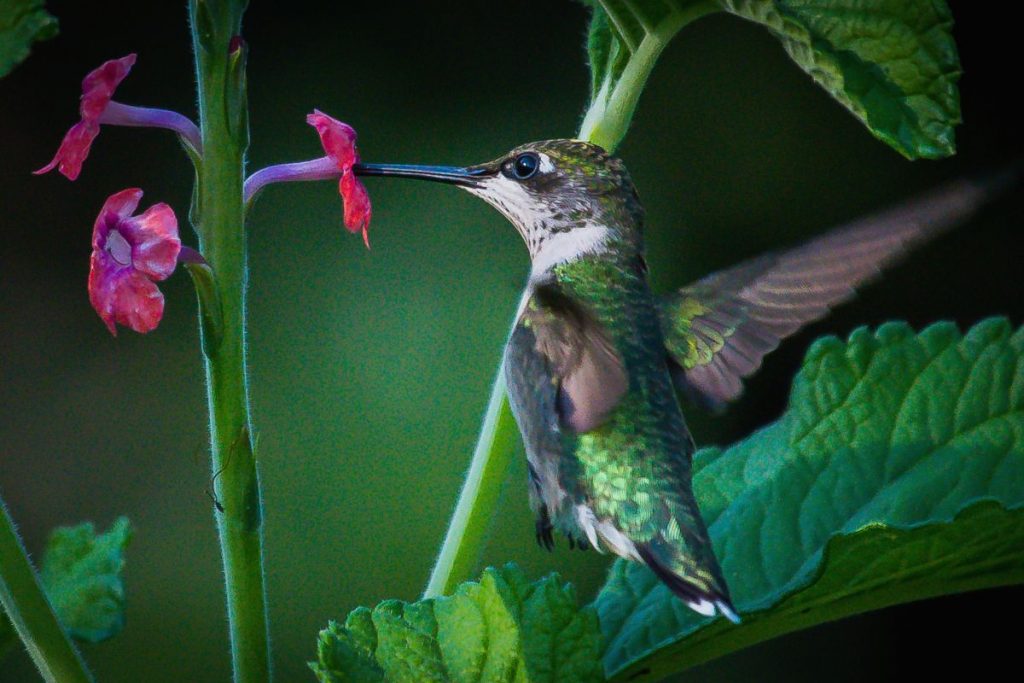Yes, hummingbirds can indeed be found in New Jersey! The most common species you’ll encounter is the Ruby-throated Hummingbird, which migrates to New Jersey in the spring and stays through the summer before heading south for the winter.
In this post, we will explore the world of hummingbirds in the Garden State, from their arrival to tips on how to attract these flying jewels to your own backyard.

The Ruby-throated Hummingbird: A Closer Look
The Ruby-throated Hummingbird (Archilochus colubris) is the only breeding hummingbird species found in New Jersey. These tiny birds, measuring around 3 to 3.5 inches in length, are known for their striking appearance and high-speed, acrobatic flight.
Male Ruby-throated Hummingbirds have an iridescent red throat patch (gorget), while females have a white throat. Both sexes have metallic green upperparts and greyish-white underparts, with the males being slightly more vibrant.
Migration Patterns and Arrival in New Jersey
Ruby-throated Hummingbirds spend their winters in Central America, mainly in Mexico, and start migrating northward as the weather begins to warm up. They typically arrive in New Jersey in mid to late April, with males arriving slightly earlier than females to establish their territories.
During their migration, Ruby-throated Hummingbirds travel incredible distances, sometimes flying over 1,500 miles in one trip. They even cross the Gulf of Mexico, a non-stop journey of around 500 miles that takes approximately 18 hours to complete.
Habitats and Nesting
In New Jersey, Ruby-throated Hummingbirds can be found in a variety of habitats, including deciduous and mixed forests, gardens, meadows, and orchards. They tend to prefer areas with a diverse mix of flowering plants, as these provide an abundance of nectar, their primary food source.
Nesting usually begins in May, with females constructing tiny, cup-shaped nests made from plant materials and spider silk lined with soft plant fibres. These nests are often located on the branches of deciduous trees or shrubs, 10 to 20 feet above the ground.
The female lays one to three eggs, which she incubates for around 12 to 14 days. After hatching, the young hummingbirds remain in the nest for approximately 18 to 22 days before they fledge.
Attracting Hummingbirds to Your Garden
Creating a hummingbird-friendly garden is an excellent way to enjoy these fascinating creatures up close. Here are some tips to help you attract Ruby-throated Hummingbirds to your New Jersey backyard:
- Plant Nectar-rich Flowers: Hummingbirds are attracted to brightly coloured, tubular flowers that produce nectar, their primary food source. Some excellent choices for your New Jersey garden include trumpet vine, bee balm, salvia, and columbine.
- Install a Hummingbird Feeder: In addition to planting flowers, you can also provide a supplemental food source by hanging a hummingbird feeder filled with sugar water. Use a mixture of one part sugar to four parts water, and avoid using red dye as it can be harmful to hummingbirds.
- Provide a Water Source: Like all birds, hummingbirds need water to drink and bathe. Consider adding a shallow bird bath or a misting system to your garden to provide a water source for these tiny visitors.
- Create Perching Spots: Hummingbirds often perch on branches to rest and survey their territory. Provide perching spots by including small trees and shrubs in your garden design.
- Minimise Pesticide Use: Pesticides can be harmful to hummingbirds and their insect prey. By reducing or eliminating pesticide use, you can create a healthier environment for hummingbirds and other wildlife.
- Offer Insect Food Sources: Although nectar is their primary food source, hummingbirds also require insects for protein. Planting a diverse range of native plants will help attract insects that hummingbirds can feed on.
- Provide Shelter: Hummingbirds need safe spaces to rest and nest. Planting dense shrubs and small trees or even providing a brush pile can offer them the shelter they need to feel secure in your garden.
- Keep Cats Indoors: Cats are a significant threat to hummingbirds and other small birds. By keeping your cat indoors or in a secure outdoor enclosure, you can help protect the local hummingbird population.
The Importance of Hummingbirds in the Ecosystem
Hummingbirds play a vital role in the ecosystem as pollinators. As they feed on nectar, they transfer pollen from one flower to another, helping plants to reproduce. In turn, this supports the growth of plants that provide food and habitat for other wildlife species.
By creating a hummingbird-friendly garden, you’re not only enjoying these remarkable birds but also contributing to the health of the local ecosystem.
A Fascinating Glimpse into Nature’s Wonders
New Jersey is fortunate to host the enchanting Ruby-throated Hummingbird during the warmer months. By learning about their habits, migration patterns, and how to attract them to your garden, you can gain a deeper appreciation for these remarkable creatures and the vital role they play in our natural world.
As you welcome these tiny avian jewels into your garden, take a moment to marvel at their beauty, agility, and resilience. The presence of hummingbirds in New Jersey is a testament to the wonder and diversity of nature, offering a captivating glimpse into the interconnectedness of life on our planet.

Challenges Facing Hummingbirds and How You Can Help
While hummingbirds are a delight to observe, they face numerous challenges that threaten their survival. Habitat loss, climate change, and the use of pesticides are just some of the factors that have led to the decline of some hummingbird populations.
Here are a few ways you can help protect these fascinating creatures and ensure they continue to grace our gardens for generations to come.
- Support Conservation Efforts: Donating to organisations dedicated to preserving and restoring hummingbird habitats is an excellent way to contribute to their conservation. These organisations often work on projects such as habitat restoration, research, and public education to ensure the long-term survival of hummingbirds and other wildlife.
- Advocate for Hummingbird-Friendly Policies: Encourage your local government to adopt policies that protect and restore hummingbird habitats, such as preserving green spaces and promoting the use of native plants in public landscaping.
- Spread the Word: Share your passion for hummingbirds with friends, family, and neighbours. Educate others about the importance of these birds and what they can do to help protect them.
- Participate in Citizen Science: Join hummingbird monitoring projects, such as Project FeederWatch or the Journey North Hummingbird Migration Tracker. These projects rely on the observations of everyday people to collect valuable data about hummingbird populations and migration patterns, contributing to our understanding of these species and informing conservation efforts.
Final Thoughts
By making your garden friendly for hummingbirds and supporting efforts to protect them, you are helping to keep these amazing birds safe.
This also helps preserve a special part of New Jersey’s natural beauty, so future generations can enjoy hummingbirds in their own backyards.
New Jersey is home to the Ruby-throated Hummingbird during the warmer months, giving everyone a chance to see these tiny, fascinating birds up close.
By learning about their needs and creating the right habitats, we can all help hummingbirds thrive in the Garden State for years to come. Let these tiny flying wonders inspire you to appreciate and protect the incredible wildlife around us.
Image Gallery – Are There Hummingbirds In New Jersey?



Related Posts to Read:
- Best Hummingbird Feeders.
- Are There Hummingbirds In Alabama?
- Are There Hummingbirds in Europe?
- Are There Hummingbirds in Australia?
- Are There Hummingbirds In The Caribbean?
- Are There Hummingbirds In Canada?
- Are There Hummingbirds In Jamaica?
- Are There Hummingbirds In Florida?
- Are There Hummingbirds In Massachusetts?
- Are There Hummingbirds In New Zealand?
- Are There Hummingbirds In Michigan?
- Are There Hummingbirds In Texas?
References:
- About Hummingbird (Wikipedia).
- About New Jersey (Wikipedia)
- Greenewalt, C. H. (1960). Hummingbirds. New York: Doubleday. Google Scholar.

This was a helpful article. I am a new lover of hummingbirds since I discovered one in my flowerbed two years ago. I have since, been building a hummingbird garden in hopes of attracting many more.
Hi Laura,
I’m glad you found the article helpful. It’s truly an amazing experience to witness the beauty of hummingbirds up close. Also, creating a hummingbird garden is a beautiful undertaking, and I’m confident that it will attract even more of these delightful birds. Keep the love going, and enjoy every moment with these charming winged wonders!
Thanks.